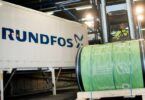In the face of growing water shortages, an increasing number of companies are water saving at the heart of their sustainability strategies. One of these is PepsiCo, which is looking to become net water positive throughout its operations. In this interview, we talked to David Grant, Sr. Director of Climate and Water Solutions at PepsiCo, about the company’s water stewardship approach and its overall aims.
A Company Background

David Grant, the Sr. Director of Climate and Water Solutions at PepsiCo
I’m David Grant, the Sr. Director of Climate and Water Solutions at PepsiCo. As part of my role, I oversee PepsiCo’s water stewardship agenda and support the company in delivering our global water strategy, as part of our PepsiCo Positive (pep+) agenda.
PepsiCo products are enjoyed by consumers more than one billion times a day in more than 200 countries and territories around the world. PepsiCo generated more than $86 billion in net revenue in 2022, driven by a complementary beverage and convenient foods portfolio that includes Lay’s, Doritos, Cheetos, Gatorade, Pepsi-Cola, Mountain Dew, Quaker and SodaStream.
PepsiCo’s Positive Agenda
PepsiCo is focused on driving positive change for the planet and people through the company’s PepsiCo Positive agenda. What is PepsiCo Positive and how does water stewardship work into this vision?
In 2021, we introduced PepsiCo Positive (pep+), PepsiCo’s new transformation strategy to grow our business while embedding sustainability into everything we do to promote positive change for the planet and people.
As part of pep+, we aim to achieve sustainable water security for our business, natural ecosystems, and the local communities that depend on accessible and reliable supply of safe, clean water. We need water for the manufacturing of our food and beverage products and to help grow the more than 30 agricultural crops and ingredients that go into making our many iconic brands. But we also were one of the first companies of our size to recognize water as a fundamental human right, and so we know how essential good water stewardship is not only for us but also for the local communities in which we operate and the natural environment.
By 2030, our vision is to be net water positive, and our hope is that our presence and action should improve the local water resources where we operate.
The Net Water Positive Vision
An important part of PepsiCo’s vision to be net water positive by 2030 is watershed management. What does it involve and what are the benefits?
Our vision to become net water positive encompasses a robust and ambitious strategy as part of our pep + agenda. This includes a set of 2030 goals aimed at becoming net water positive in our operations, enhancing watershed management as part of our regenerative agriculture goals, and contributing to community water health by delivering safe water access to 100 million people. Our water-use efficiency goals and watershed replenishment goals not only cover our owned facilities, but also our third-party manufacturing facilities in high-water risk areas. Altogether, we aim to reduce the absolute water we use and put back more water than we take from local watersheds.
We use a watershed management approach that encompasses our entire value chain and work with partners to implement a variety of initiatives that restore the health of high-risk watersheds. These efforts also create benefits that extend far beyond the quantity of water restored in a given watershed, including improved water quality, protecting and enhancing local biodiversity and aquatic wetlands, carbon sequestration, and socio-economic benefits for local communities.
I’m proud to say in 2022 we made significant progress towards our water goals, which you can read more about in our 2022 ESG Summary.
PepsiCo’s Water Positivity Plan
What projects and plans do you have in place to achieve this?
We have countless projects throughout the world that span several focus areas from improving water-use efficiency across our value chain to restoring and conserving vulnerable watersheds.
To help ensure that all our facilities are operating as efficiently as possible, for example, we have an initiative called Resource Conservation (ReCon), where teams at individual sites work to identify opportunities to become more water-use efficient at their specific locations based on the type of technologies they use. In turn, they then share their best practices across our locations globally.
We’re also investing in more advanced technologies. For example:
- At one of our snacks facilities in Kolkata, India we developed best-in-class technology to capture the inherent water released from potatoes during the chip-cooking process and convert it to clean potable water that can be used to help run the facility. This reduces the amount of freshwater needed in our operations by 50%, which adds up to a savings of up to 60 million liters of water per year.
- We’ve also operated some of our major snacks facilities across Latin America without having to extract a single drop of freshwater from municipal water supplies, creating truly circular water systems in high-stress water areas.
And at the watershed level, we know that collaboration is key, and so we partner with conservation organizations such as The Nature Conservancy (TNC) to deliver solutions. Among other projects, in South Africa, we’ve partnered with TNC to support restoring the Atlantis aquifer, Cape Town’s largest, by clearing invasive plants in the aquifer’s primary recharge zone.
What are the biggest challenges you face when implementing water stewardship across PepsiCo and the value chain?
Bringing about long-term, permanent improvements to at-risk watersheds requires scale, partnership, and engagement from all stakeholders in each catchment. Securing these is an ongoing priority as we pursue our water ambitions.
As I mentioned, PepsiCo has made progress in developing and implementing watershed-focused projects, however these projects only address part of a global challenge. If we are going to make the necessary progress, we need to address this complex issue – simply put, we need collaboration between more companies along with a range of other stakeholders including NGO’s, local government, and communities.
The Importance of Engaging with Stakeholders
How do you engage other stakeholders, such as suppliers and bottlers, to commit to water stewardship and become water positive?
A given watershed can be shared by multiple companies, communities, and governments, so working collaboratively and at scale is essential to meaningfully mitigate the impacts of water risks.
We also have 2030 goals aimed specifically at achieving best-in-class water-use efficiency standards at both our company-owned and third-party manufacturing facilities, as well as replenishing more than 100% of the water we use at such sites back into local watersheds, so it’s important for us to help bring all stakeholders along on our journey.
It’s why we’ve created a Water Stewardship Specialization program to help educate others on implementing good water stewardship practices.
PepsiCo’s Water Stewardship Specialization Program
What is PepsiCo’s Water Stewardship Specialization program and why is it important?
PepsiCo’s Water Stewardship Specialization program is a three-course series developed as an open-access, corporate water stewardship education program hosted on the Coursera online platform. Participants can study local and global water resources and develop a plan to advance water stewardship goals.
We believe the best way to tackle water stress at the watershed level is to engage all stakeholders and, through collective action, work toward a common goal of improving water governance and conservation. A critical component of working toward this vision includes bringing others along on the journey and sharing best practices, including with our suppliers and bottlers. The learning program is important to drive broader awareness for water stewardship and provide our stakeholders with the tools PepsiCo has found effective.
What are your hopes for the future of the Water Stewardship Specialization program?
We know that achieving our net water positive vision requires buy-in from everyone across our value chain and all the stakeholders in a given watershed where we operate. Good water stewardship demands increased collaboration, advocating for solutions that drive fairness and address specific needs of a given locality, the open sharing of ideas and innovations, and collaboratively driving investment and scale.
By making this program available to third-party manufacturers and bottlers throughout our value chain – in addition to anyone else who chooses to take the program – we hope we will be able to spread some of the best practices and solutions we have uncovered, help people learn about the need for good corporate water stewardship, and encourage action to help have the greatest impact.
You can sign up for the program here: PepsiCo: Water Stewardship | Coursera








